
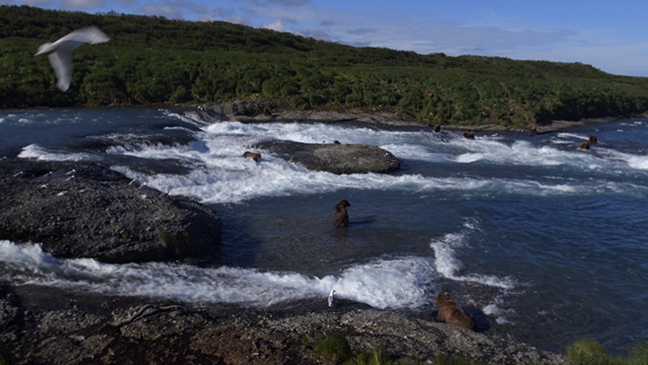
McNeil River originates from the glaciers and alpine lakes in the mountains of the Aleutian Range and flows into the Cook Inlet in southwestern Alaska, The McNeil River Sanctuary, established in 1967 and enlarged in 1993, protects about 200 square miles of wildlife habitat. About a mile upstream from the mouth of the river, McNeil River Falls slows chum salmon during their upstream migration to their spawning grounds, attracting the world's largest concentration of wild brown bears. A lottery driven permit system limits the number of guests who may be present in the sanctuary to no more than 10 between June 7 and August 25 annually.
©Rich Beckman

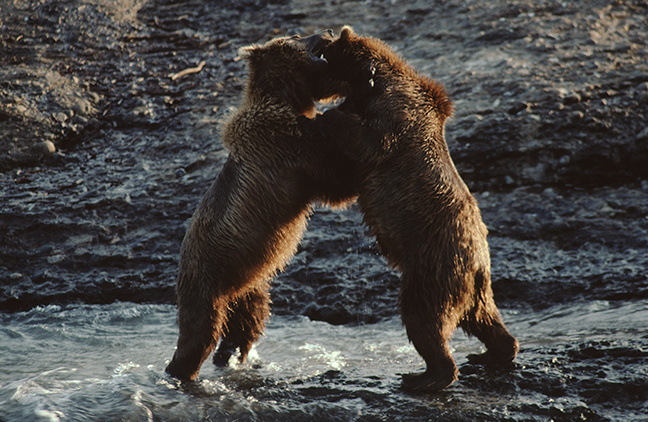
McNeil River originates from the glaciers and alpine lakes in the mountains of the Aleutian Range and flows into the Cook Inlet in southwestern Alaska, The McNeil River Sanctuary, established in 1967 and enlarged in 1993, protects about 200 square miles of wildlife habitat. About a mile upstream from the mouth of the river, McNeil River Falls slows chum salmon during their upstream migration to their spawning grounds, attracting the world's largest concentration of wild brown bears. A lottery driven permit system limits the number of guests who may be present in the sanctuary to no more than 10 between June 7 and August 25 annually.
©Rich Beckman

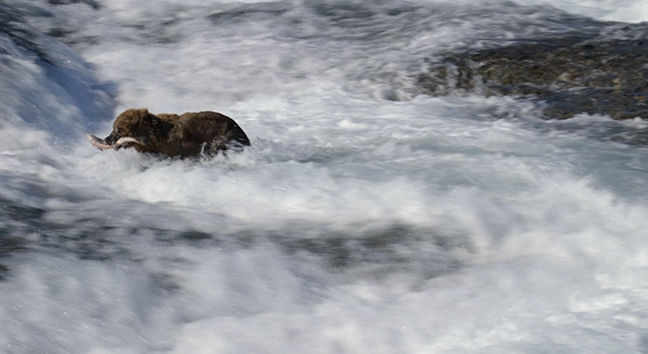
McNeil River originates from the glaciers and alpine lakes in the mountains of the Aleutian Range and flows into the Cook Inlet in southwestern Alaska, The McNeil River Sanctuary, established in 1967 and enlarged in 1993, protects about 200 square miles of wildlife habitat. About a mile upstream from the mouth of the river, McNeil River Falls slows chum salmon during their upstream migration to their spawning grounds, attracting the world's largest concentration of wild brown bears. A lottery driven permit system limits the number of guests who may be present in the sanctuary to no more than 10 between June 7 and August 25 annually.
©Rich Beckman

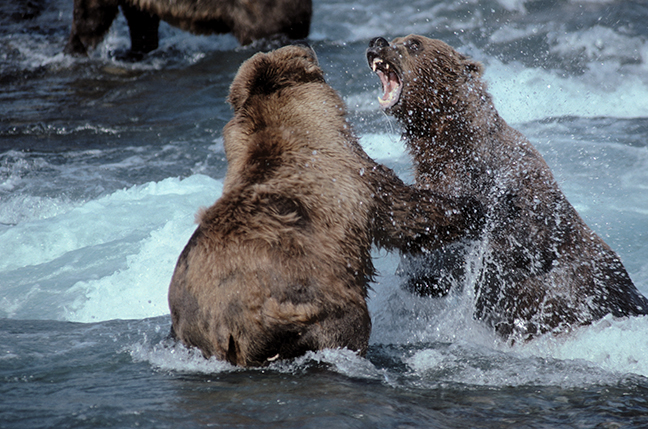
McNeil River originates from the glaciers and alpine lakes in the mountains of the Aleutian Range and flows into the Cook Inlet in southwestern Alaska, The McNeil River Sanctuary, established in 1967 and enlarged in 1993, protects about 200 square miles of wildlife habitat. About a mile upstream from the mouth of the river, McNeil River Falls slows chum salmon during their upstream migration to their spawning grounds, attracting the world's largest concentration of wild brown bears. A lottery driven permit system limits the number of guests who may be present in the sanctuary to no more than 10 between June 7 and August 25 annually.
©Rich Beckman

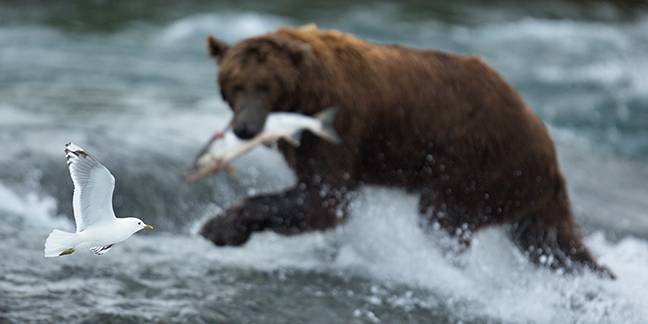
McNeil River originates from the glaciers and alpine lakes in the mountains of the Aleutian Range and flows into the Cook Inlet in southwestern Alaska, The McNeil River Sanctuary, established in 1967 and enlarged in 1993, protects about 200 square miles of wildlife habitat. About a mile upstream from the mouth of the river, McNeil River Falls slows chum salmon during their upstream migration to their spawning grounds, attracting the world's largest concentration of wild brown bears. A lottery driven permit system limits the number of guests who may be present in the sanctuary to no more than 10 between June 7 and August 25 annually.
©Rich Beckman

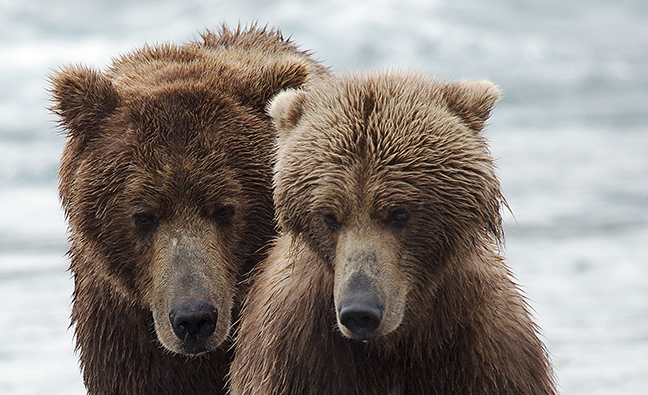
McNeil River originates from the glaciers and alpine lakes in the mountains of the Aleutian Range and flows into the Cook Inlet in southwestern Alaska, The McNeil River Sanctuary, established in 1967 and enlarged in 1993, protects about 200 square miles of wildlife habitat. About a mile upstream from the mouth of the river, McNeil River Falls slows chum salmon during their upstream migration to their spawning grounds, attracting the world's largest concentration of wild brown bears. A lottery driven permit system limits the number of guests who may be present in the sanctuary to no more than 10 between June 7 and August 25 annually.
©Rich Beckman

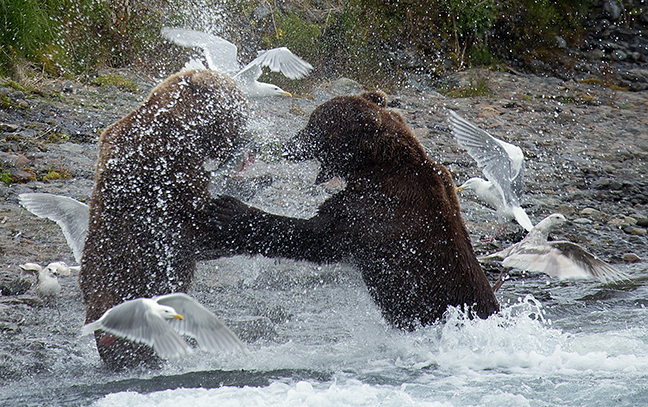
McNeil River originates from the glaciers and alpine lakes in the mountains of the Aleutian Range and flows into the Cook Inlet in southwestern Alaska, The McNeil River Sanctuary, established in 1967 and enlarged in 1993, protects about 200 square miles of wildlife habitat. About a mile upstream from the mouth of the river, McNeil River Falls slows chum salmon during their upstream migration to their spawning grounds, attracting the world's largest concentration of wild brown bears. A lottery driven permit system limits the number of guests who may be present in the sanctuary to no more than 10 between June 7 and August 25 annually.
©Rich Beckman

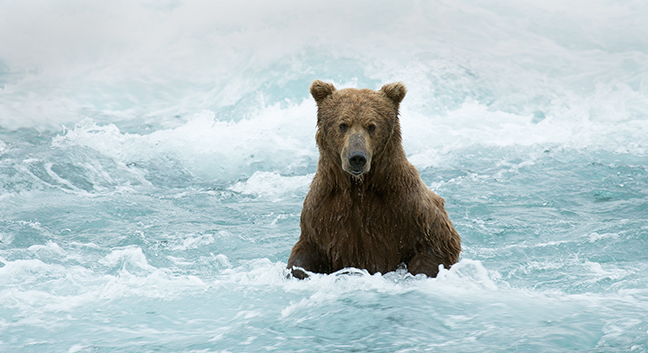
McNeil River originates from the glaciers and alpine lakes in the mountains of the Aleutian Range and flows into the Cook Inlet in southwestern Alaska, The McNeil River Sanctuary, established in 1967 and enlarged in 1993, protects about 200 square miles of wildlife habitat. About a mile upstream from the mouth of the river, McNeil River Falls slows chum salmon during their upstream migration to their spawning grounds, attracting the world's largest concentration of wild brown bears. A lottery driven permit system limits the number of guests who may be present in the sanctuary to no more than 10 between June 7 and August 25 annually.
©Rich Beckman

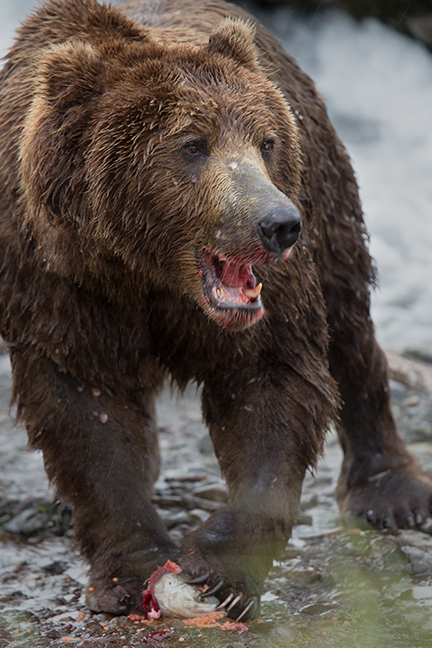
McNeil River originates from the glaciers and alpine lakes in the mountains of the Aleutian Range and flows into the Cook Inlet in southwestern Alaska, The McNeil River Sanctuary, established in 1967 and enlarged in 1993, protects about 200 square miles of wildlife habitat. About a mile upstream from the mouth of the river, McNeil River Falls slows chum salmon during their upstream migration to their spawning grounds, attracting the world's largest concentration of wild brown bears. A lottery driven permit system limits the number of guests who may be present in the sanctuary to no more than 10 between June 7 and August 25 annually.
©Rich Beckman

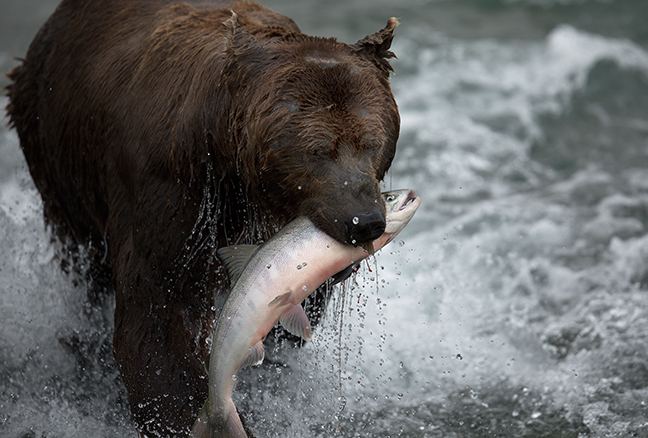
McNeil River originates from the glaciers and alpine lakes in the mountains of the Aleutian Range and flows into the Cook Inlet in southwestern Alaska, The McNeil River Sanctuary, established in 1967 and enlarged in 1993, protects about 200 square miles of wildlife habitat. About a mile upstream from the mouth of the river, McNeil River Falls slows chum salmon during their upstream migration to their spawning grounds, attracting the world's largest concentration of wild brown bears. A lottery driven permit system limits the number of guests who may be present in the sanctuary to no more than 10 between June 7 and August 25 annually.
©Rich Beckman

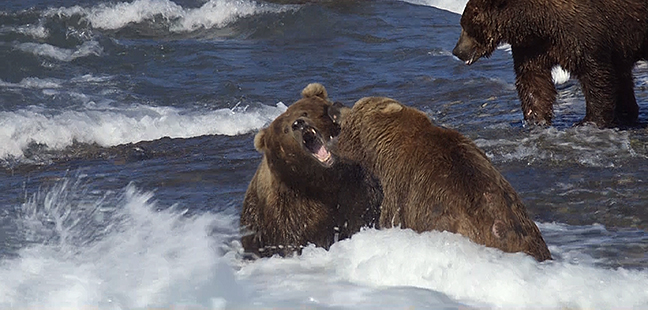
McNeil River originates from the glaciers and alpine lakes in the mountains of the Aleutian Range and flows into the Cook Inlet in southwestern Alaska, The McNeil River Sanctuary, established in 1967 and enlarged in 1993, protects about 200 square miles of wildlife habitat. About a mile upstream from the mouth of the river, McNeil River Falls slows chum salmon during their upstream migration to their spawning grounds, attracting the world's largest concentration of wild brown bears. A lottery driven permit system limits the number of guests who may be present in the sanctuary to no more than 10 between June 7 and August 25 annually.
©Rich Beckman

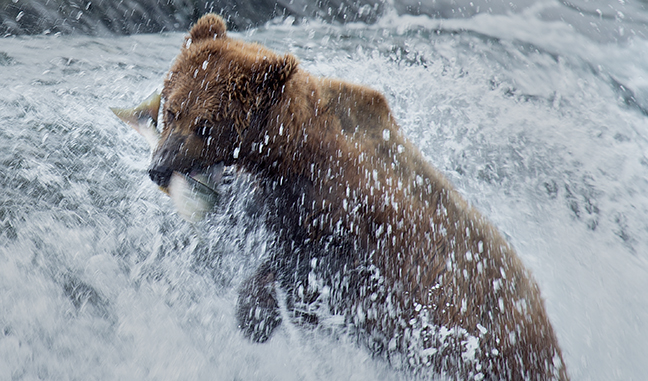
McNeil River originates from the glaciers and alpine lakes in the mountains of the Aleutian Range and flows into the Cook Inlet in southwestern Alaska, The McNeil River Sanctuary, established in 1967 and enlarged in 1993, protects about 200 square miles of wildlife habitat. About a mile upstream from the mouth of the river, McNeil River Falls slows chum salmon during their upstream migration to their spawning grounds, attracting the world's largest concentration of wild brown bears. A lottery driven permit system limits the number of guests who may be present in the sanctuary to no more than 10 between June 7 and August 25 annually.
©Rich Beckman

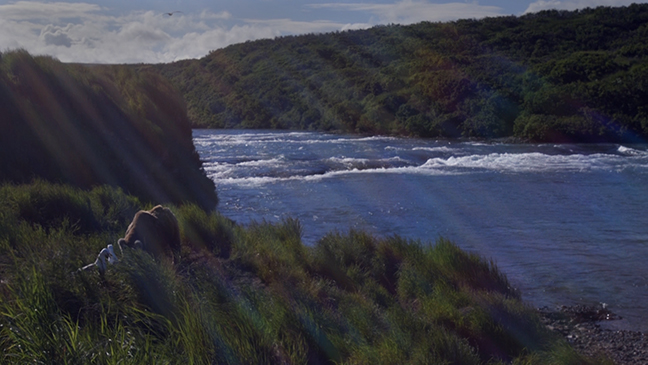
McNeil River originates from the glaciers and alpine lakes in the mountains of the Aleutian Range and flows into the Cook Inlet in southwestern Alaska, The McNeil River Sanctuary, established in 1967 and enlarged in 1993, protects about 200 square miles of wildlife habitat. About a mile upstream from the mouth of the river, McNeil River Falls slows chum salmon during their upstream migration to their spawning grounds, attracting the world's largest concentration of wild brown bears. A lottery driven permit system limits the number of guests who may be present in the sanctuary to no more than 10 between June 7 and August 25 annually.
©Rich Beckman

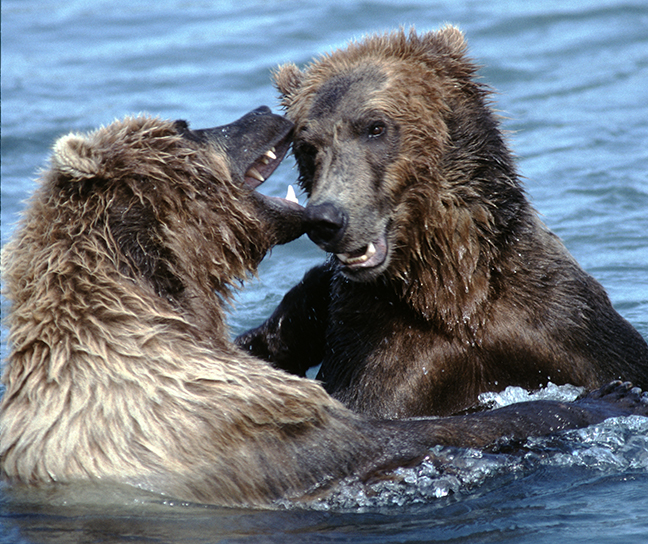
McNeil River originates from the glaciers and alpine lakes in the mountains of the Aleutian Range and flows into the Cook Inlet in southwestern Alaska, The McNeil River Sanctuary, established in 1967 and enlarged in 1993, protects about 200 square miles of wildlife habitat. About a mile upstream from the mouth of the river, McNeil River Falls slows chum salmon during their upstream migration to their spawning grounds, attracting the world's largest concentration of wild brown bears. A lottery driven permit system limits the number of guests who may be present in the sanctuary to no more than 10 between June 7 and August 25 annually.
©Rich Beckman

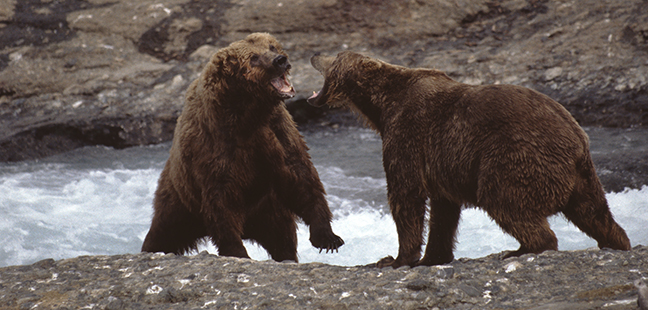
McNeil River originates from the glaciers and alpine lakes in the mountains of the Aleutian Range and flows into the Cook Inlet in southwestern Alaska, The McNeil River Sanctuary, established in 1967 and enlarged in 1993, protects about 200 square miles of wildlife habitat. About a mile upstream from the mouth of the river, McNeil River Falls slows chum salmon during their upstream migration to their spawning grounds, attracting the world's largest concentration of wild brown bears. A lottery driven permit system limits the number of guests who may be present in the sanctuary to no more than 10 between June 7 and August 25 annually.
©Rich Beckman

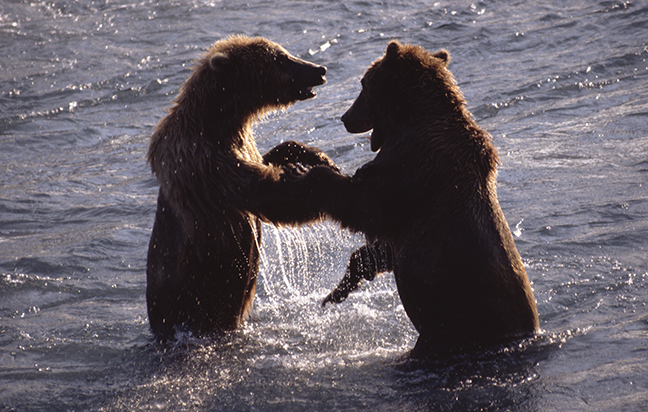
McNeil River originates from the glaciers and alpine lakes in the mountains of the Aleutian Range and flows into the Cook Inlet in southwestern Alaska, The McNeil River Sanctuary, established in 1967 and enlarged in 1993, protects about 200 square miles of wildlife habitat. About a mile upstream from the mouth of the river, McNeil River Falls slows chum salmon during their upstream migration to their spawning grounds, attracting the world's largest concentration of wild brown bears. A lottery driven permit system limits the number of guests who may be present in the sanctuary to no more than 10 between June 7 and August 25 annually.
©Rich Beckman

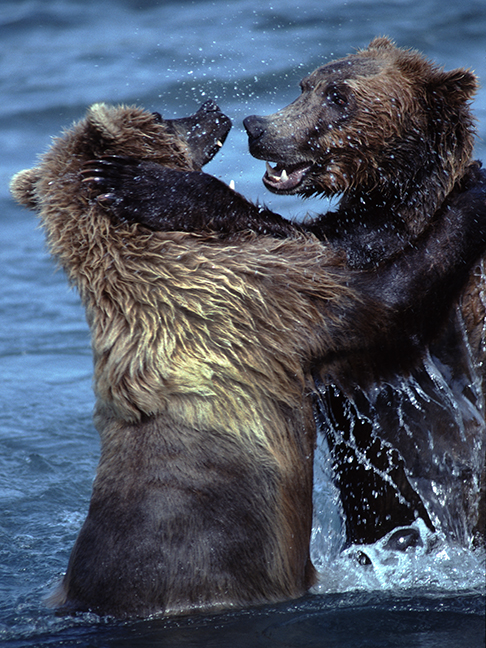
McNeil River originates from the glaciers and alpine lakes in the mountains of the Aleutian Range and flows into the Cook Inlet in southwestern Alaska, The McNeil River Sanctuary, established in 1967 and enlarged in 1993, protects about 200 square miles of wildlife habitat. About a mile upstream from the mouth of the river, McNeil River Falls slows chum salmon during their upstream migration to their spawning grounds, attracting the world's largest concentration of wild brown bears. A lottery driven permit system limits the number of guests who may be present in the sanctuary to no more than 10 between June 7 and August 25 annually.
©Rich Beckman

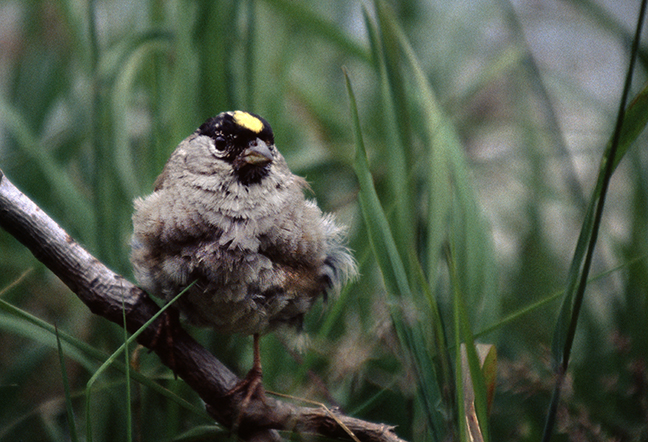
In summer, Golden-crowned Sparrows nest in the tundra and shrublands from British Columbia to Alaska usually along the treeline. They feed on seeds and insects on the ground and in low vegetation. Their song consists of three plaintive minor-key whistles, descending in pitch. It is very distinctive, and often described as sounding like 'oh-dear-me.'
©Rich Beckman